AMD Kaveri Review: A8-7600 and A10-7850K Tested
by Ian Cutress & Rahul Garg on January 14, 2014 8:00 AM ESTDrawing Performance Conclusions
As I progressed through the testing for this review, I became aware of trends in two things: absolute performance, in terms of numbers, and generational improvements across platforms. With AMD moving the Bulldozer based architectures from Piledriver in Trinity and Richland to Steamroller in Kaveri, the base CPU design has had a relatively long run in order to be optimized to the limitations on the CPU side. Obviously AMD has also had a chance to change the lithography node in there as well, and as such has optimized for design rather than performance. This matters a great deal when we look at the power banding (45W, 65W, 95W) and performance in each segment.
In order to display just how much Kaveri has grown in relation to the previous generations, I processed our mountain of data to show graphs where percentage gain against the older generations really does matter. As mentioned previously in this review, it all depends on whether the software can take advantage of the new features afforded by the architecture. In this review we have spent a lot of time discussing advantages for Kaveri in terms of compute (HSA, hUMA, hQ) and gaming (Mantle, TrueAudio), but some of these are still a little way off for software integration. So what does that translate to if you are looking for an APU today – does Kaveri still expand its wings with the integration of the GCN architecture, or does it lag behind due to the lithography node no longer being optimized for frequency. The proof is in the results.
IGP Gaming, 1280x1024
For the 100W APUs at 1280x1024, there is almost no movement between the Richland and the Kaveri APUs, except for Company of Heroes which would seem to leverage the extra SPs more than the MHz available.
45W APUs are clearly in vogue at 1280x1024, each of them providing a good bump over Richland.
IGP Gaming, 1680x1050
1680x1050 sees more benefit for the 100W APUs, but the 45W APUs still show big leaps.
IGP Gaming, 1920x1080
At 1080p the effects are more pronounced all around.
CPU Timed Benchmarks
Unfortunately the CPU timed benchmarks at 100W are bit over the place. Here we are dealing with an IPC gain but MHz deficit, and each benchmark has a different way of dealing with it. For Agisoft, MHz wins, but for Xilisoft, the Kaveri improvements work out well for the system.
At 45W the situation is a lot more clearer, and the newer APUs have the advantage, especially in Adobe After Effects.
CPU Score Benchmarks
45W still makes the biggest jump when it comes to score based CPU benchmarks.
IGP Synthetics
I never like putting much thought into the synthetic results – here both the 100W and the 45W range are showing good improvements all around. 3DMark 06 has the most trouble getting improvements as it relies more on the grunt, rather than the features that Kaveri affords.
IGP Compute
Off the bat we can see just how much of a difference the Kaveri GPU Compute can make over previous APUs. This is still without hUMA fully being in effect while we wait for a proper driver and software stack to become available.
Up to a +222% boost from Kaveri is amazing for a 45W part.
AMD vs Intel
For a little tete-a-tete, putting the 65W Iris Pro up against the 65W Kaveri seems like a good idea. To add to the mix, due to the extreme price difference of Iris Pro in this equation, we also add the 95 W Kaveri for comparison.
It is interesting to note that at the lower resolutions the Iris Pro wins on most benchmarks, but when the resolution and complexity is turned up, especially in Sleeping Dogs, the Kaveri APUs are in the lead.


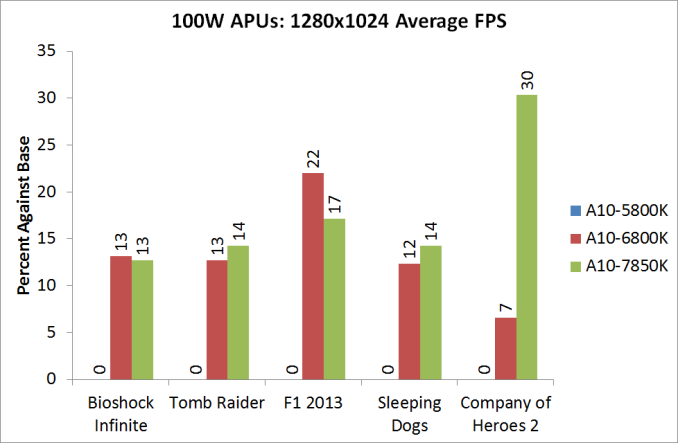
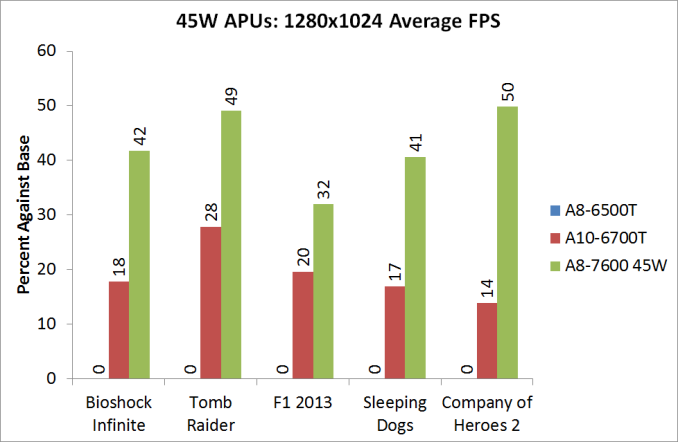
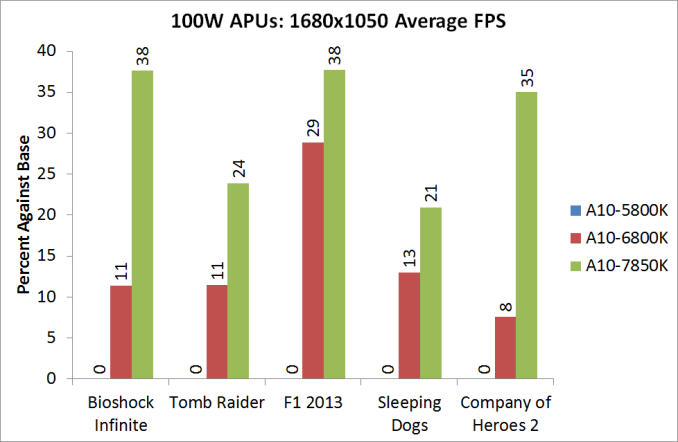
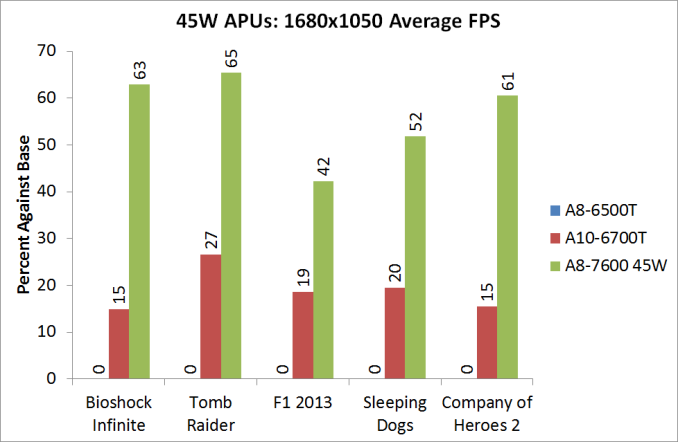
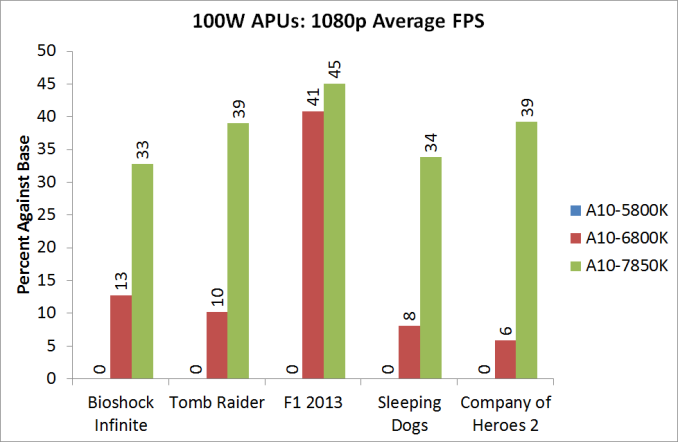

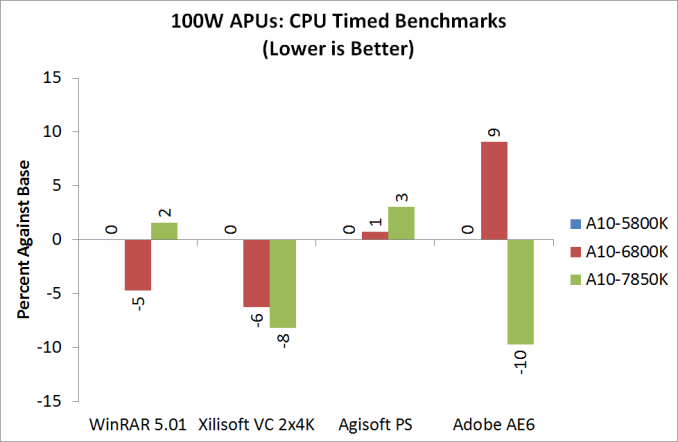
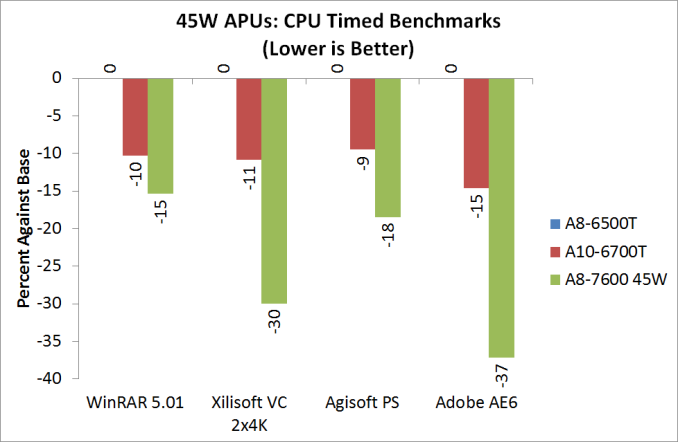

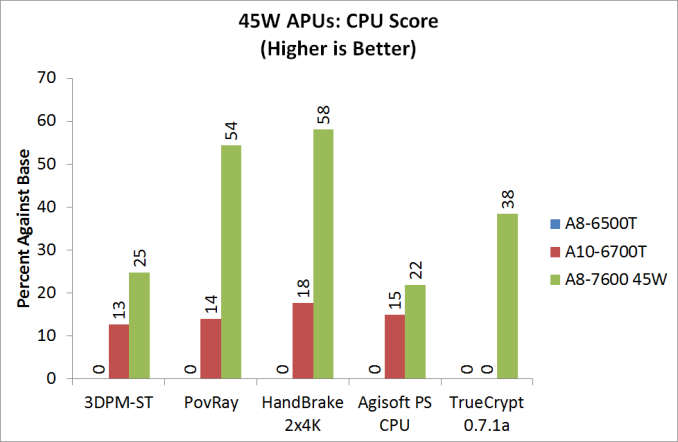
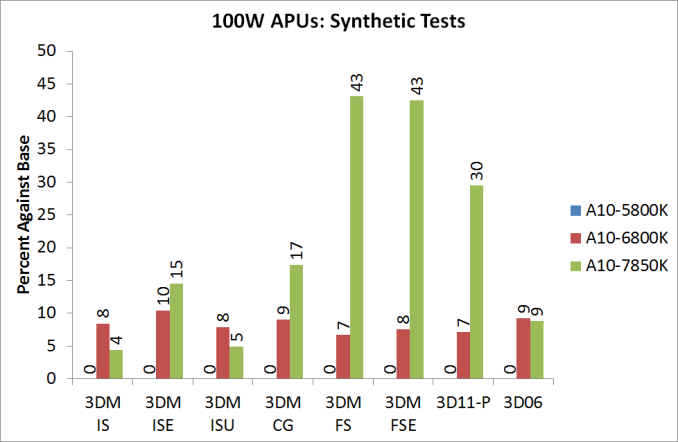
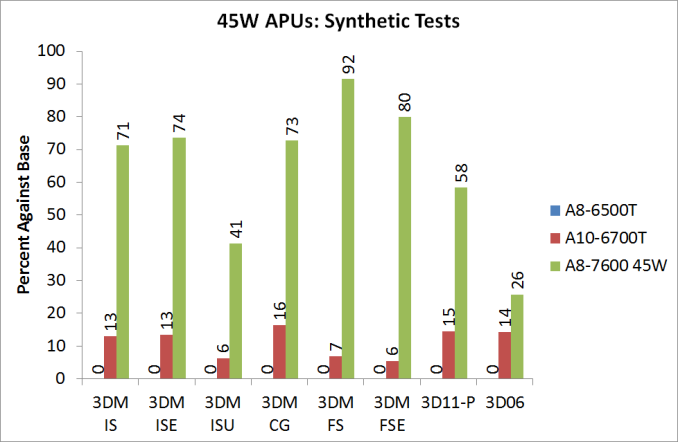
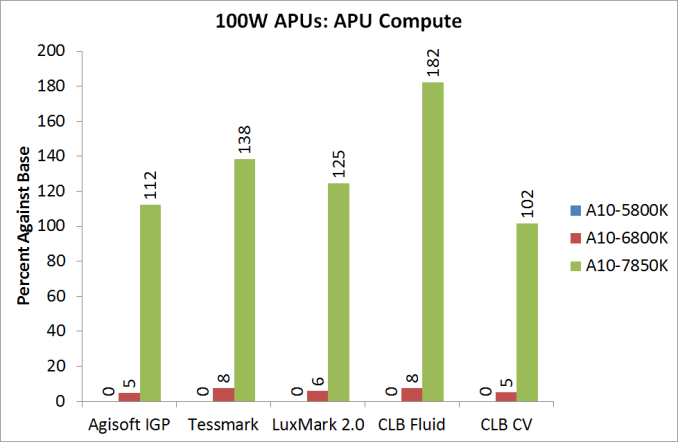

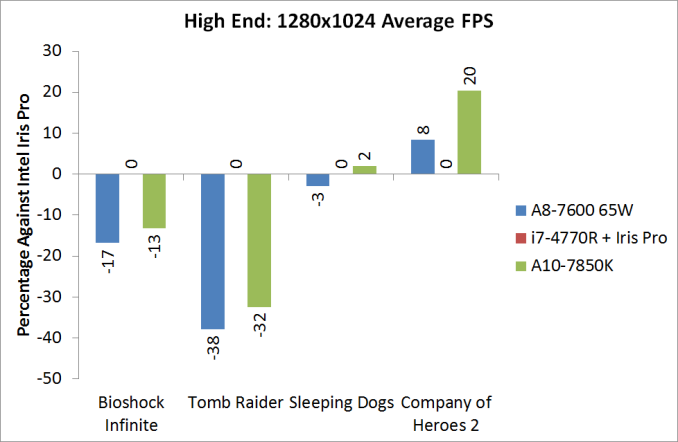
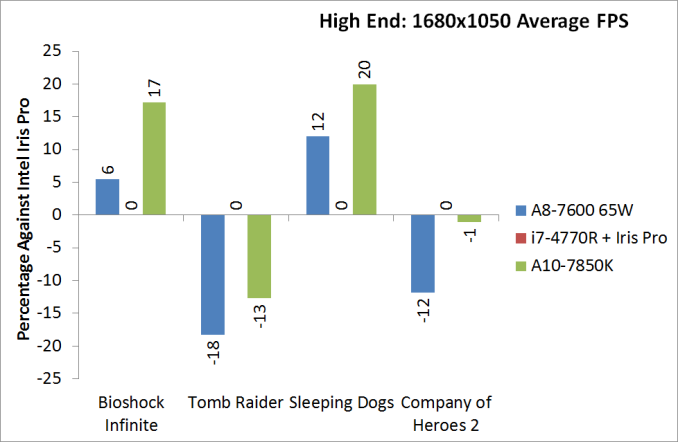
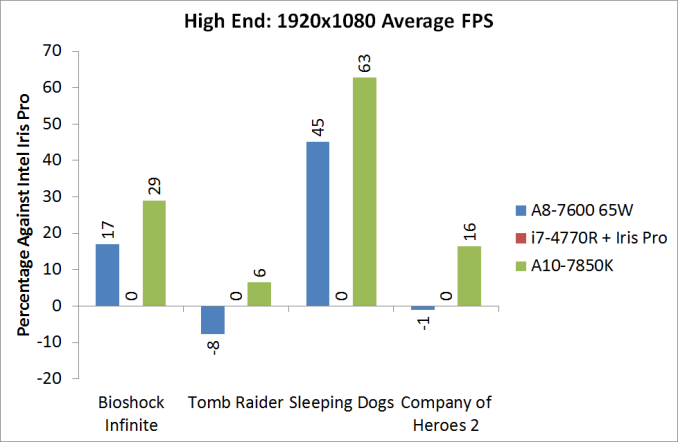








380 Comments
View All Comments
boozed - Tuesday, January 14, 2014 - link
You must be a hoot at parties.boozed - Wednesday, January 15, 2014 - link
And I hit reply on the wrong bloody comment. My apologies...monsieurrigsby - Wednesday, January 29, 2014 - link
I'm a bit slow to the party, but talk of discrete GPUs leads me to the main question I still have that I don't see explained (possibly because the authors assume deeper understanding of CPU/GPU programming), and haven't seen discussed elsewhere. (I've not looked *that* hard...)If you have a Kaveri APU and a mid/high-end discrete GPU that won't work with Dual Graphics (if it arrives), what processing can and can't use the on-APU GPU? If we're talking games (the main scenario), what can developers offload onto the onboard GPU and what can't they? What depends on the nature of the discrete card (e.g., are modern AMD ones 'HSA enabled' in some way?)? If you *do* have a Dual Graphics capable discrete GPU, does this still limit what you can *explicitly* farm off to the onboard GPU?
My layman's guess is that GPU compute stuff can still be done but, without dual graphics, stuff to do with actual frame rendering can't. (I don't know enough about GPU programming to know how well-defined that latter bit is...)
It's just that that seems the obvious question for the gaming consumer: if I have a discrete card, in what contexts is the on-APU GPU 'wasted' and when could it be used (and how much depends on what the discrete card is)? And I guess the related point is how much effort is the latter, and so how likely are we to see elements of it?
Am I missing something that's clear?
monsieurrigsby - Wednesday, January 29, 2014 - link
Plus detail on Mantle seems to suggest that this might provide more control in this area? But are there certain types of things which would be *dependent* on Mantle?http://hothardware.com/News/How-AMDs-Mantle-Will-R...
nissangtr786 - Tuesday, January 14, 2014 - link
I told amd fanboys the fpu on intel and the raw mflops mips ofintel cpu destroy current a10 apus, its no real suprise all those improvement show very little in benchmarks with kaveri steamroller cores. amd fanboys said it will reach i5 2500k performance, I said i3 4130 but overall i3 4130 will be faster in raw performance and I am right. I personally have an i5 4430 and it looks like i5's still destroy these a10 apu in raw performance.http://browser.primatelabs.com/geekbench3/326781
browser.primatelabs.com/geekbench3/321256
a10-7850k Sharpen Filter Multi-core 5846 4.33 Gflops
browser.primatelabs.com/geekbench3/321256
i5 4430 Sharpen Filter Multi-core 11421 8.46 Gflops
gngl - Tuesday, January 14, 2014 - link
"I personally have an i5 4430 and it looks like i5's still destroy these a10 apu in raw performance."You seem to have a very peculiar notion of what "raw performance" means, if you're measuring it in terms of what one specific benchmark does with one specific part of the chip. There's nothing raw about a particular piece of code executing a specific real-world benchmark using a particular sequence of instructions.
chrnochime - Tuesday, January 14, 2014 - link
Who cares what CPU you have anyway. If you want to show off, tell us you have at least a 4670k and not a 4430. LOLkeveazy - Tuesday, January 14, 2014 - link
It's relevant that he used the i5 4430 in his comment. Compare the price range and you'll see. These AMD apu's are useless unless your just looking to build a PC that's not meant to handle heavily threaded tasks.tcube - Thursday, January 16, 2014 - link
Ok... heavily threaded tasks ok... examples! Give me one example of one software 90% of pc users use 90% of the time that this apu can't handle... then and ONLY then is the cpu relevant! Other then that it's just bragging rights and microseconds nobody cares about on a PC!Instead we do care to have a chip that plays anything from hd video to AAA 3d games and also is fast enough for anything else and don't need a gpu for extra cost, power usage heat and noise! And that ain't any intel that fits on a budget!
keveazy - Saturday, January 18, 2014 - link
I'll give you 1 example. Battlefield 4.